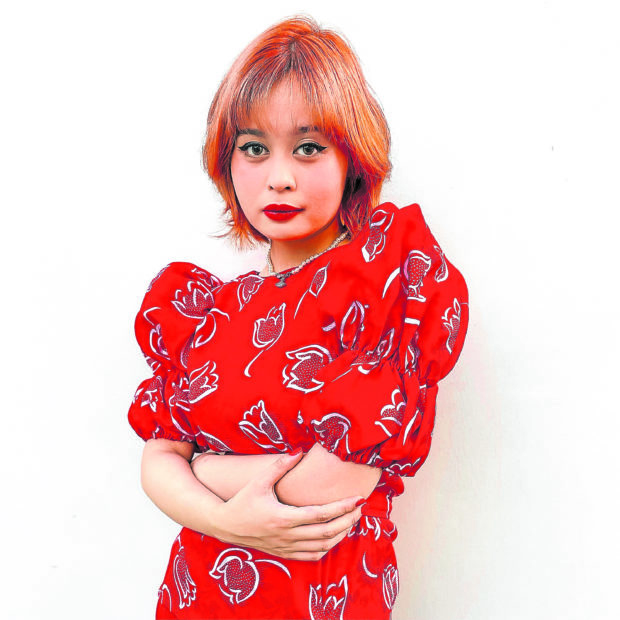A fashion collection can be a thoughtful tribute, as three Fashion Design and Merchandising graduates of De La Salle-College of Saint Benilde showed through their contemporary designs produced over the pandemic. One is an homage to overseas Filipino workers (OFWs), another celebrates Korean-Filipino culture, while the other addresses stigmatized women.
Pamela Madlangbayan’s “Balikbayan” is composed of pieces featuring inscriptions and symbols often found on balikbayan boxes, or the supersized, tightly packed cardboard box filled with goodies that has become the symbol of family-oriented Filipino culture.
“My great-grandmother, grandmother and father are all OFWs,” Madlangbayan, 24, said. “Balikbayan boxes, for me, were always something to look forward to during my childhood.”
She reimagined the traditional Filipiniana silhouettes like the terno, traje de mestiza, tapis and barong, and added graphic embellishments to make “a fun and upbeat collection dedicated to the joy and excitement of homecoming, and love that transcends oceans.”

She described the pieces as having a “high-low look,” with formal elements such as the butterfly-sleeve tops layered with corsets and cardboard-brown wrap skirts.
The clothes, mostly in custom-printed duchess satin and gazar, are inscribed with texts usually found on balikbayan boxes (“Fragile,” “Handle with Care”) created through a “scanography” technique done by photographer and artist Ricardo Cruz Yan. Actual packaging tape and stickers were scanned to create a design and the prints were transferred on the textiles.
Madlangbayan made the collection while quarantined in Manila before going back to Japan where her family is. “I graduated from elementary and senior high school in Japan, so it’s more like going home than migrating to work,” she said.
She works in Osaka, and recently volunteered to design costumes made with unconventional and upcycled materials for a modern dance performance called “Kanashimi wo Kiku Ishi,” which premiered in the Kobe Fashion Museum. All proceeds of the show were donated to Dear Me, a Japanese organization that supports the education of less fortunate Filipino children.

“I want to use art to reach out to people who are less privileged than I am, so being able to help children follow their dreams means so much,” she said. (Email pamrmad@gmail.com; follow Pamela Madlangbayan on Facebook, @pammadla on Instagram)
K-fashion
Eunhye “Grace” Cho’s women’s wear are actually fashion installations. For her collection, “Oriental Fusion: Bloom,” the Filipino-Korean designer made white sculptural clothes using screen-door wire, paper and LED lights. The inspirations were the traditional Korean hanji lantern and chang-ho window, and the Filipino capiz shell window.
“I noticed that many of my Filipino batchmates were watching K-dramas and know about K-pop really well,” she said. “I was really proud to be Korean, and decided to use hanbok materials in collaboration with the brand Piña Cocoon, to show how beautiful these two elements can go together.”
She highlights the heritage and culture of the Philippines and Korea in her clothes, as Cho’s parents are Korean missionaries who migrated to the Philippines when she was younger.
“The hardships that I encountered in my youth have taught me to be constantly grateful for the things that I have,” Cho, 23, said. “Living as a young immigrant in the Philippines, I also learned to trust that any obstacle can be overcome if you remain resilient in the face of failure. It is the epitome of finding balance between two cultural identities.”
Sold under her brand La Grâce (“grace” in French), the clothes are made for women of all ages looking for “glamorous and gorgeous formal looks.”
Cho’s flowy clothes evoke movement, and were inspired by her background in watercolor painting. The colors are reminiscent of her favorite flowers, peonies and roses. “Their shades have brought out ideas that exude femininity and luxury in many of the clothing I’ve designed,” Cho said.
“I believe there is great power in the clothes we wear…I hope my work gives people the feeling of self-satisfaction and this magic called ‘confidence.’”
Cho now works as a merchandiser and web designer in Korea, and has adjusted to the “new normal,” but keeps her designs visible on social media.
“Without it, the audience will not even know that we designers exist in fashion.” Email lagraceofficial2020@gmail.com; @lagraceofficial on InstagramNSFW collection
Fresh graduate Sean Carlo Betco, 22, has a daring collection dedicated to “breaking the stigma among comfort women of all sorts, from entertainers, dancers, to sex workers.” The collection, “P*ta” (yes, the curse word), is his call “to open a discussion about the lack of protection of women in the sex industry.”
“Before shifting to fashion, I was taking up political science, and I still want a part of that to influence my designs,” he said. “I want people to know that fashion is not just all about glamour. It is also a great avenue to address social and political issues.”
His sensual pieces feature silhouettes that accentuate the curves of the body with details done through lacing and corsetry. Materials are mainly sculpted liquid latex and mesh fabric “to showcase intimacy.” One red dress has a base made of gauze, tissue paper and textile acrylic held together by liquid latex.
“I tried to work on a limited budget and resources… and focus on craftsmanship and artistry instead,” he said. “I worked with fairly priced materials such as mesh, organza and spandex, while focusing on textile manipulation by sculpting liquid rubber latex.”
Betco has an ongoing collaboration with “a big e-commerce brand” and is working on expanding his design portfolio with other young artists, graphic designers and photographers.
“The pandemic has also made me more aware of how much fashion is negatively affecting our environment, and I have been putting out a lot of upcycling and deconstruction projects,” he said.
Email scqbetco@gmail.com; follow @seanbetco, @betco.studio on Instagram. INQ

